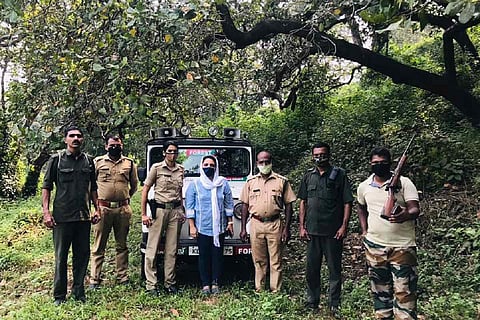

For the last several days, a group of forest officials have been trying to drive away wild elephants roaming around Aralam farm in Kannur district, located near the Aralam wildlife sanctuary. Though they were able to drive a few away, some still remain on the farm. The Aralam farm has made headlines for many years due to man-animal conflicts. In the last six years, eight people have died as a result of elephant attacks.
Tribal people, who live inside the farm and labourers of Aralam Farm Corporation (Kerala) Ltd. (AFCL), have been the victims in these incidents. The most recent death was on October 31. Eighteen-year-old Vibeesh, from the tribal settlement inside the farm, was killed by a wild elephant.
"It is not the same group that visits the farm every time. As per our estimate, there might be 20 to 30 different herds of elephants that come to the farm. We always drive them back to the forest; we have special teams to do that," Aralam wildlife warden Shajna Karim told TNM. In the first week of November, when the officials were trying to move a herd of elephants back into the forest, they noticed a mother elephant giving birth at the farm. She was protected by a group of 11 other elephants, who covered the mother and the baby.
However, for residents of the farm, it is not easy living in constant fear. They had earlier held a 'jeevan raksha' (protect lives) march. Though the forest department had spent crores of rupees on the farm for constructing fences — rapid response teams have also been deployed for protection — nothing has worked.
It is estimated that in the last 18 months, the losses caused due to wild elephants were around Rs 5 crore.
"We live in fear. Not only the fear of losing life but also fear of losing everything we planted. We are scared to walk around or go for some work. People who go to collect cashew nuts or collect some logs of wood are scared to venture out. Sometimes, we escape just by sheer luck. There is not even a day that we sleep in peace," said Rathish, one of the residents.
Watch video of officials searching for wild elephants:
Aralam farm has 7,500 acres, where 4,054 acres are resettlement areas. About 3,314 Adivasi families have been assigned one acre each on the farm, but many of them have not yet settled there. A large number of coconut trees and cashew nut trees have also been destroyed by the elephants at the farm, causing major concern for the people living there.
Shajna said that the elephants prefer the farm area, even though food and water are available in the wildlife sanctuary nearby. "Like in other places, these wild elephants raid crops and leave, and do not settle down on the farms. Besides, farming is done only in a small tract of land. The vacant land has now become a forest as it has been overrun with weeds," she added.
Elephants visit the farm almost every month. Usually, when the bushes are cleared in the farm after weeding, they are driven back within two or three days. However, it is taking longer now because weeding has not been conducted as yet and the entire area is covered in thick foliage, making it hard for officials to spot the elephants.
E Unnikrishnan, an environmental activist and writer, said it was wrong to rehabilitate the tribals near the sanctuary. "The settlements are on the border of the forest. It should have been done on the other side of the farm near to the road, away from the sanctuary, so that the conflict would have been reduced," he said.
"An area close to the forest should be considered a buffer zone,” he added.
Advocate Vinod Payyada, who is also an environmentalist, said that the area where the farm exists might have once been the habitat of elephants, and they continue to visit even after it was converted to farmland.
"It is said that elephants know the paths and places where their ancestors travelled. That is why we have the concept of elephant corridors. Another major reason for elephants coming to the farm is intensive quarrying happening around the sanctuary. Loud sounds and disturbances drive them to come out of the forest," he said.
"Food and water is another major attraction. Since fruits and other crops are easily available, and so they prefer coming to the farm. They are coming for temporary needs, so they won't settle down in these areas. They go back to their habitat," added Vinod.